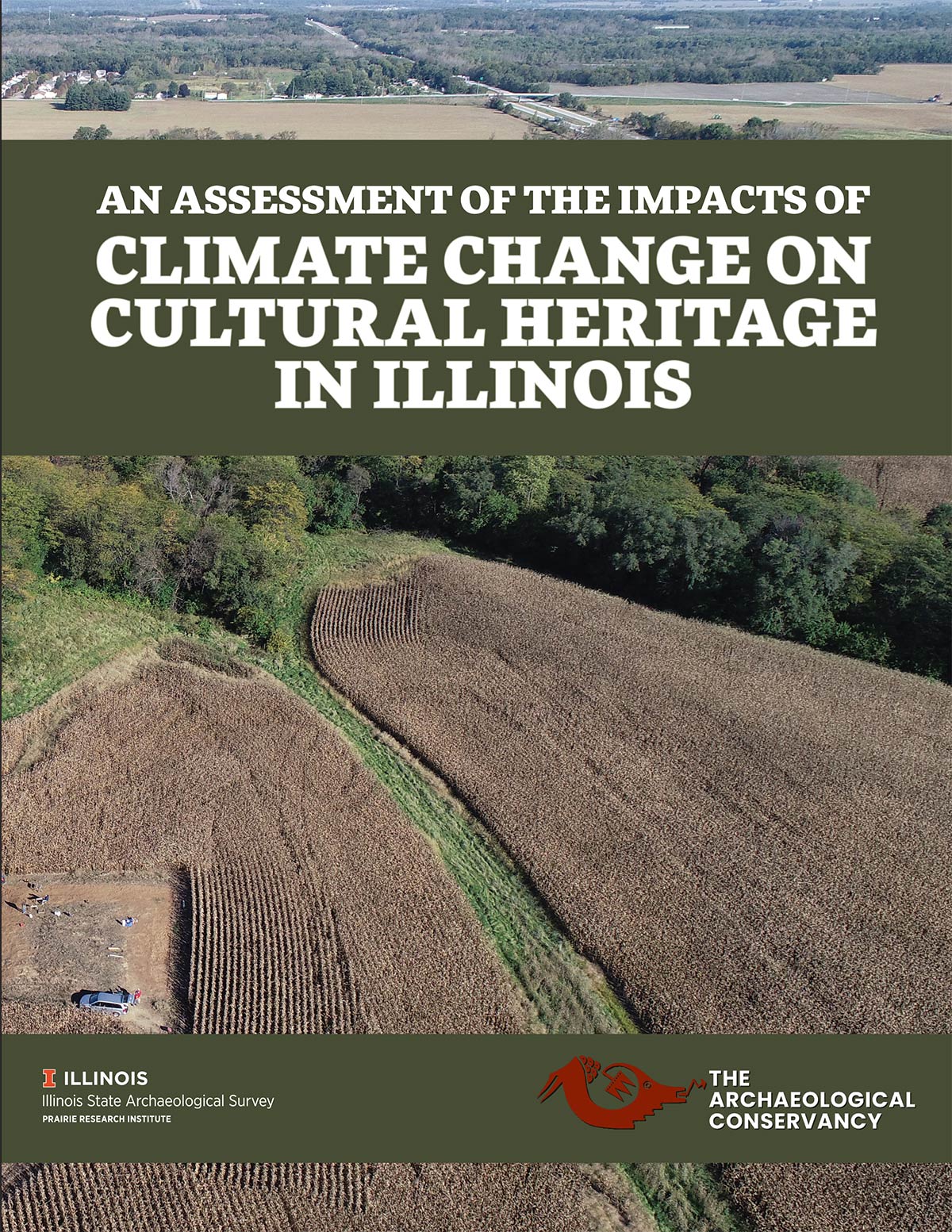Climate Change and the Cultural Heritage of Illinois
 ISAS' report can be downloaded as a PDF.
ISAS' report can be downloaded as a PDF.
An Assessment of the Impacts of Climate Change on Cultural Heritage in Illinois is a new report created by ISAS (with the support of the Archaeological Conservancy) to help the public understand the threat that cultural heritage resources in Illinois face from climate change. This report discusses the importance of cultural resources and how Indigenous societies in Illinois responded to periods of climate change in the ancient past. It describes the vulnerabilities of cultural resources to soil erosion and flooding and presents projections for how future demographic changes may impact both known and undiscovered cultural resources. The report concludes with broad strategies to protect our state’s irreplaceable cultural heritage now and into the future.
In 2021, climatologists, hydrologists, and ecologists produced a study of climate impacts to hydrology, agriculture, human health and native ecosystems in Illinois. They reported on the science of how increasingly intense precipitation events will lead to more severe floods, rapid-onset droughts will impact agriculture and increase the risk of wildfires, and poorer air quality and heat stress will affect health. In the face of these changes, people will make decisions on where and how they want to live, which can lead to large-scale migration and demographic changes.
But how might climate change affect cultural heritage in our state? Tens of thousands of cultural sites from the precontact and historical eras make up the shared cultural heritage of Illinois. These sites, often preserved just below the ground surface, were the homes of Indigenous Illinoisans going back 13,000 years and, more recently, historic-era Euroamericans, Black Americans, and others. The places where history took place provide tangible evidence of the daily life of generations of people that called this landscape home. Many are also sacred places of great importance to descendant communities—mounds, burial grounds, and shrines—that are imbued with meaning by virtue of their connection to ancestors and the presence of cultural belongings.
Archaeologists and architectural historians at the Illinois State Archaeological Survey are doing our part to anticipate and respond to the impacts climate change will have on our heritage resources. Our Illinois Climate Change Modeling Initiative (ICCMI) combines our expertise as archaeologists and historians with the latest climate modeling projections to assess how climate change may impact cultural heritage sites across the state. We leverage databases like the Illinois Inventory of Archaeological Sites (IIAS); our existing Illinois Archaeological Predictive Model (IAPM); historical data on precipitation, soils, and demography; census data; and new climate models to examine how soil erosion, flooding, and demographic changes may affect both known and undiscovered cultural heritage sites.
Most heritage resources are fragile, and few have any protection from damage or destruction from erosion, flooding, development, and other expected effects of climate change (Figure 1). These impacts are irreversible, and archaeological sites are not a renewable resource. Mitigating the effects of climate change on cultural heritage sites will involve hard choices about what to save and how to save it.
 Figure 1. Large erosional gully at an archaeological site in St. Clair County, IL. Potsherds and other artifacts are actively eroding out of the cutbank in the foreground. Archaeologists for scale. (click to enlarge image). Photo courtesy of Tim Pauketat.
Figure 1. Large erosional gully at an archaeological site in St. Clair County, IL. Potsherds and other artifacts are actively eroding out of the cutbank in the foreground. Archaeologists for scale. (click to enlarge image). Photo courtesy of Tim Pauketat.
 Figure 2. ISAS scientists studying rates of soil erosion in an agricultural field using a drone to collect detailed surface elevation data.
Figure 2. ISAS scientists studying rates of soil erosion in an agricultural field using a drone to collect detailed surface elevation data.
Our effort is part of broader initiatives to protect archaeology in the United States from climate change, including NAHAR (North American Heritage at Risk), the Society for Historic Archaeology’s HARC (Heritage at Risk Committee), and the Society for California Archaeology’s Climate Change and California Archaeology study. The Society for American Archaeology’s statement on climate change (2022) acknowledges the problem’s scope and urges it to be a priority for “archaeologists, community partners, relevant regulatory agencies, and local, state, and federal governments.” Most of these efforts focus on how rising sea levels threaten sites on the nation’s coastlines, leaving Illinois and other parts of the interior underrepresented in the discussion.
We consider this report a “version 1.0” and welcome future opportunities to work with communities, agencies, landowners, and other interested parties. ISAS is developing research across multiple scales, from monitoring rates of erosion at specific cultural sites (Figure 2), to refining our models using new climate projections. While our efforts have focused on state-wide analyses, down-scaled models relevant to community-specific hazard management plans are also possible, as are larger-scale models of regional impacts.